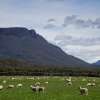
Planting trees of tomorrow: Students create living legacy
Posted 30 July 2024
Exeter High School Farm, in collaboration with the Forest Education Foundation, is proud to announce the establishment of a multi-species shelterbelt on the school property.
Students have planted 575 trees to form a one-acre shelterbelt as part of the Revitalising School Farms program.
The project aims to demonstrate the benefits of shelterbelts consisting of various commercial and native species on a farming enterprise and to serve as a learning resource for year 9 to 12 students to compare species performance and silvicultural treatments.
Forest Education Foundation partnered with Private Forests Tasmania for planning, species selection, planting and shelterbelt maintenance, worked with Sustainable Timber Tasmania and Forico to supply seedlings.
Exeter School Farm’s year 11/12 Agriculture students are involved in site preparation and fencing.
Forest Education Foundation manager Darcy Vickers said the shelterbelt project is a key component of the Forest Education Foundation’s 2024 School Grants Program, which aims to provide valuable educational experiences in agriculture and forestry for students.
“This project is a wonderful example of what can be achieved through active collaboration between forest industry partners and education,” Mr Vickers said.
“The FEF works closely with educators to identify teaching and learning opportunities that support the Australian Curriculum and reflect best practice teaching approaches.
“These students have clearly demonstrated what can be achieved when given the opportunity to take ownership of their learning through real world experiences.”
Earlier this year, Exeter High School Farm’s year 11/12 agriculture class participated in an immersive Agriculture/Forestry Camp where students toured the Agricultural Training Centre of Excellence at Burnie TasTAFE, Forico Nursery in Somerset, and Surrey Hills Estate.
Exeter High School Farm teacher Liam Fox said students gained firsthand experience with harvesting operations, woodchip milling, and the Fibre Tech Lab, highlighting the pathway from seed to fine printing paper and the connections between forestry and agriculture.
“Students gain practical experience in planting and caring for trees and will learn about the role of shelterbelts on farms, creating habitats and promoting biodiversity,” Mr Fox said.
“This project promotes awareness of sustainable farming practices and their benefits, and introduces students to potential career paths in forestry, agriculture, and environmental science.
“This program provides a lasting educational resource that future students from across North Tasmania can access and learn from.”
Following the shelterbelt planting, Forest Education Foundation is developing an additional field experience with Private Forests Tasmania which will focus on managing trees and forests on private properties to enhance overall farm health and productivity.

Private Forests Tasmania agriforester Molly Marshall said trees came with many economic, productivity and environmental benefits for Tasmanian landowners, however, considered planning and management was required to ensure the investment pays off.
“The plantings being conducted at Exeter school will add some much-needed shelter to their school farm and will provide on-farm demonstrations of how trees can be integrated into the agricultural landscape,” Ms Marshall said.
“When PFT assessed the area for potential species and future management the team looked at the school’s objectives and constraints, site conditions (rainfall, soil type, area, frost days etc.), learning exercises, existing infrastructure and the future of the plantings.
“The Manuka and Paperbark trees will provide habitat and pollen for insects, birds and native animals.
“The blackwood, eucalypts and pine will provide similar benefits, but will also be used for the students to explore how commercial trees can be managed to create different end timber products.
“Form pruning, clearwood pruning and thinning will be conducted during the life span of the shelterbelt to illustrate to the students how you can manipulate trees through their management to suit your objectives.”
Exeter High School Farm shelterbelt details:
- Species and suppliers:
- Manuka (STT): 60 trees
- Paperbark (STT): 55 trees
- Radiata pine (STT): 115 trees
- Eucalyptus globulus (Forico): 115 trees
- Eucalyptus nitens (Forico): 115 trees
- Acacia melanoxylon (Forico): 115 trees
- Planting area: About 4,022 m² (330 x 12 metres)






























